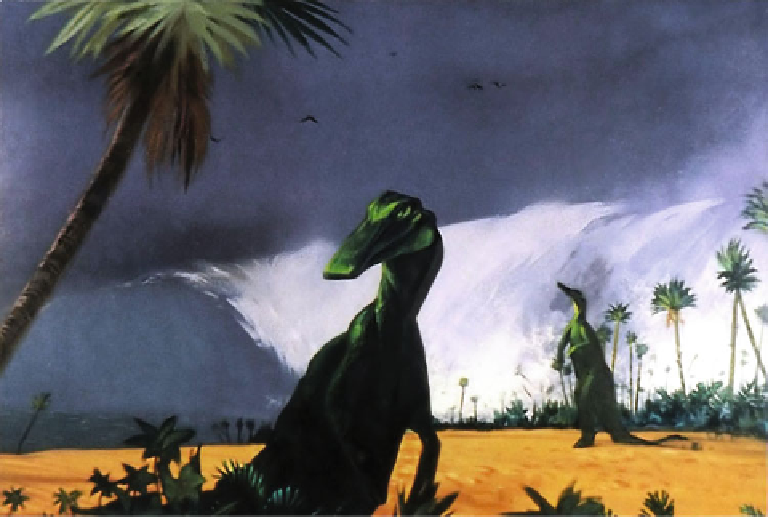Geoscience Reference
In-Depth Information
Fig. 9.1
An artist's impression
of the Chicxulub impact tsunami
as it crossed the coastal plain of
the United States. The impact
event was responsible for the
extinction of the dinosaurs,
65 million years ago. The figure
appeared originally in Alvarez
(
1997
). Ron Miller 1997 and
reprinted by permission
dozen asteroid objects 0.5-2.0 km in diameter. There may
be another 100 objects in this size range yet to be discov-
ered in the complex. The breakup of the original comet also
generated four prominent meteor showers appearing annu-
ally with a major peak in October-December and a minor
peak in April-June. One prominent reactivated comet, P/
Encke, is part of the Taurid complex. Comet P/Encke first
appeared in 1786 following the last large display of mete-
orites associated with the Taurids. Comet P/Encke is about
5 km in diameter, has a mass of 10
13
tonnes, and orbits the
Sun every 3.5 years in an Earth crossing orbit. The Taurid
complex also contains other large objects that presently
have orbits that intersect the Earth in the last few days of
June each year. The Tunguska airburst of June 30, 1908 was
a Taurid object. It was about 60 m in diameter and exploded
8-9 km above the Podkamennaya Tunguska River in
Siberia, flattening 2,150 km
2
of forest (Asher et al.
1994
).
Also considered part of the Taurids was a 1 km sized object
that struck the far side of the Moon on June 19, 1178. This
latter event produced the 20 km diameter Giordano Bruno
crater as well as spreading dust across the face of the New
Moon, splitting the upper horn with flame, and causing the
moon to ''throb like a wounded snake''. The Monk Ger-
vasse, in Kent England, witnessed the event. The event
itself may have sent debris crashing into the Earth several
days later.
Despite the image conveyed by disaster movies such as
Deep Impact and Armageddon, the risk from large asteroids
or comets is minor. The main perceived threat comes from
objects 1-10 km in size that, before the 1990s, had escaped
detection (Verschuur
1996
). However, NASA has since
instituted a dedicated program called Spaceguard to detect
90 % of objects greater than 1 km in size (National Aero-
nautics and Space Administration
2013
). As of October
2013, 959 Near Earth Objects (NEOs) larger than 1 km in
diameter have been discovered, consisting dominantly of
Apollo asteroids. Only 94 of the NEOs are comets. The
largest NEO is about 31 km in diameter. The threat from
large asteroids may be illusionary when compared to that
posed by objects less than 100 m in diameter. There are
3,800 of these objects with the potential to generate dev-
astating regional tsunami. However, none of these objects
pose an immediate threat over the next few centuries. The
present threat is still random and unpreventable. The
probability of an impact by a 1 km diameter object is
estimated from the Spaceguard observations to be one every
half million years. As of 2013, no feasible program has been
developed to mitigate the threat from cosmogenic tsunami.
The perceived view that relatively small NEOs hundreds
of meters in size are innocuous is misleading (Verschuur
1996
; Lewis
1999
). For example, a 100-500 m diameter
object moving at a velocity of 30 km s
-1
will release
energy equivalent to 100-30,000 megatons of TNT. The
large asteroid 1989FC, which was 500 m in diameter and
missed the Earth by 650,000 km, would have destroyed
civilization if it had hit our planet. It would have created a
crater about 10 km in diameter, released energy equivalent
to the world's total nuclear arsenal, triggered an earthquake
with a hypothesized magnitude, M
s
, of 9-10, ignited tens of
thousands of square kilometers of forest, ejected billions of
tonnes of rocks and dust into the atmosphere with conse-
quent lowering of temperatures and partial blocking of

